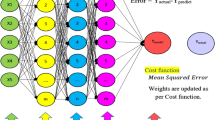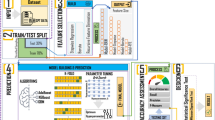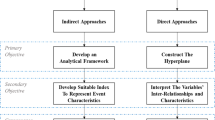Abstract
Evaluation of earthquake-induced liquefaction potential is crucial in the design phase of construction projects. Although several machine learning models achieve good prediction accuracy on their particular datasets, they may not perform well in other liquefaction datasets. To address this issue, we proposed a novel hybrid classifier ensemble to improve generalizability by combining the predictions of seven base classifiers using the weighted voting method. The applied base classifiers include back propagation neural network, support vector machine, decision tree, k-nearest neighbours, logistic regression, multiple linear regression and naïve Bayes. The hyperparameters and weights of the base classifiers were tuned using the genetic algorithm. To verify the robustness of the classifier ensemble, its performance was tested on three datasets collected from previous published researches. The results show that the proposed classifier ensemble outperforms the base classifiers in terms of a variety of performance metrics including accuracy, Kappa, precision, recall, F1 score, AUC and ROC on the three datasets. In addition, the importance of influencing variables was achieved by the classifier ensemble on the three datasets to facilitate the future data collecting work. This robust ensemble method can be extended to solve other classification problems in civil engineering.









Similar content being viewed by others
References
Lashkari A, Karimi A, Fakharian K, Kaviani-Hamedani F (2017) Prediction of undrained behavior of isotropically and anisotropically consolidated Firoozkuh sand: instability and flow liquefaction. Int J Geomech 17:04017083
Dobry R, Abdoun T (2017) Recent findings on liquefaction triggering in clean and silty sands during earthquakes. J Geotech Geoenviron Eng 143:04017077
Hazout L, Zitouni ZE-A, Belkhatir M, Schanz T (2017) Evaluation of static liquefaction characteristics of saturated loose sand through the mean grain size and extreme grain sizes. Geotech Geol Eng 35:2079–2105
Shivaprakash B, Dinesh S (2017) Dynamic properties of sand–fines mixtures. Geotech Geol Eng 35:2327–2337
Johari A, Pour JR, Javadi A (2015) Reliability analysis of static liquefaction of loose sand using the random finite element method. Eng Comput 32:2100–2119
Huang S, Huang M, Lyu Y (2019) A novel approach for sand liquefaction prediction via local mean-based pseudo nearest neighbor algorithm and its engineering application. Adv Eng Inform 41:100918
Sun Y, Li G, Zhang J et al (2020) Experimental and numerical investigation on a novel support system for controlling roadway deformation in underground coal mines. Energy Sci Eng, 8(2):490–500
Yazdi J, Moss R (2016) Nonparametric liquefaction triggering and postliquefaction deformations. J Geotech Geoenviron Eng 143:04016105
Andrus RD, Stokoe KH II (2000) Liquefaction resistance of soils from shear-wave velocity. J Geotech Geoenviron Eng 126:1015–1025
Wu J, Seed RB (2004) Estimation of liquefaction-induced ground settlement (case studies). In: Proceedings of the 5th international conference on case histories in geotechnical engineering, vol 6. Springer
Tsaparli V, Kontoe S, Taborda DM, Potts DM (2017) An energy-based interpretation of sand liquefaction due to vertical ground motion. Comput Geotech 90:1–13
Gao X, Sun Q, Xu H, Gao J (2020) Sparse and collaborative representation based kernel pairwise linear regression for image set classification. Expert Syst Appl 140:112886
Gao J, Li L (2019) A robust geometric mean-based subspace discriminant analysis feature extraction approach for image set classification. Optik 199:163368
Gao J, Li L, Guo B (2020) A new extend face representation method for face recognition. Neural Process Lett 51:473–486
Gao X, Sun Q, Xu H, Wei D, Gao J (2019) Multi-model fusion metric learning for image set classification. Knowl Based Syst 164:253–264
Hanna AM, Ural D, Saygili G (2007) Neural network model for liquefaction potential in soil deposits using Turkey and Taiwan earthquake data. Soil Dyn Earthq Eng 27:521–540
Chern S-G, Lee C-Y, Wang C-C (2008) CPT-based liquefaction assessment by using fuzzy-neural network. J Mar Sci Technol 16:139–148
Kayadelen C (2011) Soil liquefaction modeling by genetic expression programming and neuro-fuzzy. Expert Syst Appl 38:4080–4087
Xue X, Yang X (2016) Seismic liquefaction potential assessed by support vector machines approaches. Bull Eng Geol Env 75:153–162
Hu J-L, Tang X-W, Qiu J-N (2016) Assessment of seismic liquefaction potential based on Bayesian network constructed from domain knowledge and history data. Soil Dyn Earthq Eng 89:49–60
Ardakani A, Kohestani V (2015) Evaluation of liquefaction potential based on CPT results using C4.5 decision tree. J AI Data Min 3:85–92
Kohestani V, Hassanlourad M, Ardakani A (2015) Evaluation of liquefaction potential based on CPT data using random forest. Nat Hazards 79:1079–1089
Zhang W, Goh AT, Zhang Y, Chen Y, Xiao Y (2015) Assessment of soil liquefaction based on capacity energy concept and multivariate adaptive regression splines. Eng Geol 188:29–37
Xu H, Caramanis C, Mannor S (2011) Sparse algorithms are not stable: a no-free-lunch theorem. IEEE Trans Pattern Anal Mach Intell 34:187–193
Zhou Z-H, Wu J, Tang W (2002) Ensembling neural networks: many could be better than all. Artif Intell 137:239–263
Zhang J, Li D, Wang Y (2020) Predicting tunnel squeezing using a hybrid classifier ensemble with incomplete data. Bull Eng Geol Environ. https://doi.org/10.1007/s10064-020-01747-5
Freund Y, Schapire RE (1997) A decision-theoretic generalization of on-line learning and an application to boosting. J Comput Syst Sci 55:119–139
Breiman L (1996) Bagging predictors. Mach Learn 24:123–140
Wolpert DH (1992) Stacked generalization. Neural Netw 5:241–259
Kuncheva LI, Rodríguez JJ (2014) A weighted voting framework for classifiers ensembles. Knowl Inf Syst 38:259–275
Werbin-Ofir H, Dery L, Shmueli E (2019) Beyond majority: label ranking ensembles based on voting rules. Expert Syst Appl 136:50–61
Ekbal A, Saha S (2011) A multiobjective simulated annealing approach for classifier ensemble: named entity recognition in Indian languages as case studies. Expert Syst Appl 38:14760–14772
Ekbal A, Saha S (2011) Weighted vote-based classifier ensemble for named entity recognition: a genetic algorithm-based approach. ACM Trans Asian Lang Inf Process 10:9
Kim H, Kim H, Moon H, Ahn H (2011) A weight-adjusted voting algorithm for ensembles of classifiers. J Korean Stat Soc 40:437–449
Yang XS (2010) Nature-inspired metaheuristic algorithms. Luniver Press
Zhang J, Huang Y, Wang Y et al (2020) Multi-objective optimization of concrete mixture proportions using machine learning and metaheuristic algorithms. Constr Build Mater 253:119208
Zhang J, Huang Y, Ma G et al (2020) Multi-objective beetle antennae search algorithm. arXiv:2002.10090
Goh AT, Goh S (2007) Support vector machines: their use in geotechnical engineering as illustrated using seismic liquefaction data. Comput Geotech 34:410–421
Juang CH, Chen CJ (2000) A rational method for development of limit state for liquefaction evaluation based on shear wave velocity measurements. Int J Numer Anal Methods Geomech 24:1–27
Koo TK, Li MY (2016) A guideline of selecting and reporting intraclass correlation coefficients for reliability research. J Chiropractic Med 15:155–163
Shalev-Shwartz S, Ben-David S (2014) Understanding machine learning: From theory to algorithms. Cambridge University Press, Cambridge
Flach P (2012) Machine learning: the art and science of algorithms that make sense of data. Cambridge University Press, Cambridge
Hecht-Nielsen R (1992) Theory of the backpropagation neural network, neural networks for perception. Elsevier, Amsterdam, pp 65–93
Sun Y, Zhang J, Li G et al (2019) Optimized neural network using beetle antennae search for predicting the unconfined compressive strength of jet grouting coalcretes. Int J Numer Anal Methods Geomech 43(4):801–813
Scholkopf B, Smola AJ (2001) Learning with kernels: support vector machines, regularization, optimization, and beyond. MIT Press, Cambridge
Zhang J, Huang Y, Ma G et al (2020) A metaheuristic-optimized multi-output model for predicting multiple properties of pervious concrete. Constr Build Mater 249:118803
Sun Y, Zhang J, Li G et al (2019) Determination of young's modulus of jet grouted coalcretes using an intelligent model. Eng Geol 252:43–53
Sun J, Zhang J, Gu Y et al (2019) Prediction of permeability and unconfined compressive strength of pervious concrete using evolved support vector regression. Constr Build Mater 207:440–449
Quinlan JR (2014) C4.5: programs for machine learning. Elsevier, Amsterdam
Breiman L (2017) Classification and regression trees. Routledge, Abingdon
Zhang J, Ma G, Huang Y et al (2019) Modelling uniaxial compressive strength of lightweight self-compacting concrete using random forest regression. Constr Build Mater 210:713–719
Zhang J, Li D, Wang Y (2020) Predicting uniaxial compressive strength of oil palm shell concrete using a hybrid artificial intelligence model. J Build Eng 30:101282
Zhang J, Li D, Wang Y (2020) Toward intelligent construction: prediction of mechanical properties of manufactured-sand concrete using tree-based models. J Clean Prod 258:120665
Cunningham P, Delany SJ (2007) k-Nearest neighbour classifiers. Mult Classif Syst 34:1–17
Berger JO (2013) Statistical decision theory and Bayesian analysis. Springer, Berlin
Menard S (2002) Applied logistic regression analysis. Sage, Thousand Oaks
Kutner MH, Nachtsheim CJ, Neter J, Li W (2005) Applied linear statistical models. McGraw-Hill, Boston
Sokolova M, Lapalme G (2009) A systematic analysis of performance measures for classification tasks. Inf Process Manag 45:427–437
Kraemer HC (2014) Kappa coefficient, Wiley StatsRef: Statistics Reference Online, pp 1–4
Fawcett T (2006) An introduction to ROC analysis. Pattern Recogn Lett 27:861–874
Kohavi R (1995) A study of cross-validation and bootstrap for accuracy estimation and model selection. IJCAI, Montreal, pp 1137–1145
Holland JH (1992) Adaptation in natural and artificial systems: an introductory analysis with applications to biology, control, and artificial intelligence. MIT Press, Amsterdam
Schmitt LM (2001) Theory of genetic algorithms. Theoret Comput Sci 259:1–61
Goldberg DE (2006) Genetic algorithms. Pearson Education India, Bengaluru
Goldberg DE, Deb K (1991) A comparative analysis of selection schemes used in genetic algorithms, foundations of genetic algorithms. Elsevier, Amsterdam, pp 69–93
Baker JE (1985) Adaptive selection methods for genetic algorithms. In: Proceedings of an international conference on genetic algorithms and their applications. Hillsdale, New Jersey, pp 101–111
Hancock PJ (1994) An empirical comparison of selection methods in evolutionary algorithms. AISB workshop on evolutionary computing. Springer, pp 80–94
Gupta S (2009) Relative fitness scaling for improving efficiency of proportionate selection in genetic algorithms. In: Proceedings of the 11th annual conference companion on genetic and evolutionary computation conference: late breaking papers, 2009, pp 2741–2744
Vose MD (1999) The simple genetic algorithm: foundations and theory. MIT Press, Cambridge
Hassanat AB, Alkafaween EA (2017) On enhancing genetic algorithms using new crossovers. Int J Comput Appl Technol 55:202–212
Hassanat A, Almohammadi K, Alkafaween E, Abunawas E, Hammouri A, Prasath V (2019) Choosing mutation and crossover ratios for genetic algorithms—a review with a new dynamic approach. Information 10:390
Segura C, Coello CAC, Segredo E, Aguirre AH (2015) A novel diversity-based replacement strategy for evolutionary algorithms. IEEE Trans Cybern 46:3233–3246
Tóth N, Pataki B (2008) Classification confidence weighted majority voting using decision tree classifiers. Int J Intell Comput Cybern 1:169–192
Landis JR, Koch GG (1977) The measurement of observer agreement for categorical data. Biometrics 33:159–174
Genuer R, Poggi J-M, Tuleau-Malot C (2010) Variable selection using random forests. Pattern Recogn Lett 31:2225–2236
Hoang N-D, Bui DT (2018) Predicting earthquake-induced soil liquefaction based on a hybridization of kernel Fisher discriminant analysis and a least squares support vector machine: a multi-dataset study. Bull Eng Geol Environ 77:191–204
Gandomi AH, Fridline MM, Roke DA (2013) Decision tree approach for soil liquefaction assessment. Sci World J 2013:346285
Zhou J, Li E, Wang M, Chen X, Shi X, Jiang L (2019) Feasibility of stochastic gradient boosting approach for evaluating seismic liquefaction potential based on SPT and CPT case histories. J Perform Constr Facil 33:04019024
Muduli PK, Das SK (2014) CPT-based seismic liquefaction potential evaluation using multi-gene genetic programming approach. Indian Geotech J 44:86–93
Muduli PK, Das SK (2015) Evaluation of liquefaction potential of soil based on shear wave velocity using multi-gene genetic programming, handbook of genetic programming applications. Springer, Berlin, pp 309–343
Acknowledgements
The first author is supported by the China Scholarship Council (Grant Number: 201706460008).
Author information
Authors and Affiliations
Corresponding author
Ethics declarations
Conflict of interest
All the authors declare that there is no conflict of interests regarding the publication of this article.
Additional information
Publisher's Note
Springer Nature remains neutral with regard to jurisdictional claims in published maps and institutional affiliations.
Rights and permissions
About this article
Cite this article
Zhang, J., Wang, Y. An ensemble method to improve prediction of earthquake-induced soil liquefaction: a multi-dataset study. Neural Comput & Applic 33, 1533–1546 (2021). https://doi.org/10.1007/s00521-020-05084-2
Received:
Accepted:
Published:
Issue Date:
DOI: https://doi.org/10.1007/s00521-020-05084-2




